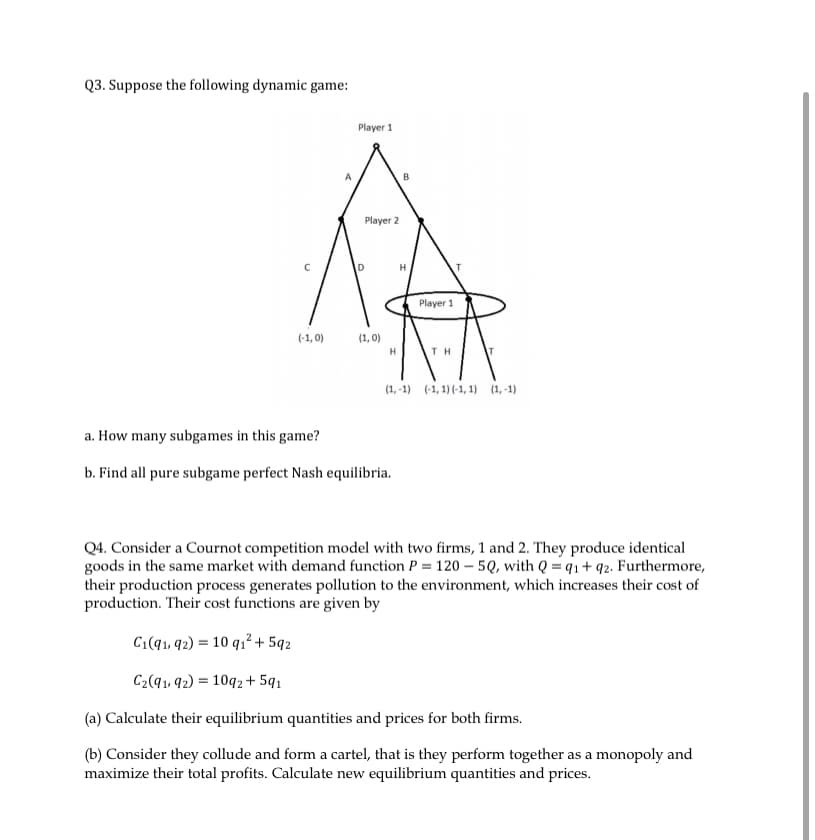Q4. Consider a Cournot competition model with two firms, 1 and 2. They produce identical goods in the same market with demand function P = 120-5Q, with Q=q1+q2. Furthermore, their production process generates pollution to the environment, which increases their cost of production. Their cost functions are given by C₁(91, 92) = 10 q1²+5qz C₂(91, 92) = 1092 +591 (a) Calculate their equilibrium quantities and prices for both firms. (b) Consider they collude and form a cartel, that is they perform together as a monopoly and maximize their total profits. Calculate new equilibrium quantities and prices.
Q4. Consider a Cournot competition model with two firms, 1 and 2. They produce identical goods in the same market with demand function P = 120-5Q, with Q=q1+q2. Furthermore, their production process generates pollution to the environment, which increases their cost of production. Their cost functions are given by C₁(91, 92) = 10 q1²+5qz C₂(91, 92) = 1092 +591 (a) Calculate their equilibrium quantities and prices for both firms. (b) Consider they collude and form a cartel, that is they perform together as a monopoly and maximize their total profits. Calculate new equilibrium quantities and prices.
Managerial Economics: A Problem Solving Approach
5th Edition
ISBN:9781337106665
Author:Luke M. Froeb, Brian T. McCann, Michael R. Ward, Mike Shor
Publisher:Luke M. Froeb, Brian T. McCann, Michael R. Ward, Mike Shor
Chapter15: Strategic Games
Section: Chapter Questions
Problem 8MC
Related questions
Question
Please help with #4- A and B

Transcribed Image Text:Q3. Suppose the following dynamic game:
(-1,0)
A
Player 1
Player 2
(1,0)
H
H
a. How many subgames in this game?
b. Find all pure subgame perfect Nash equilibria.
Player 1
ΤΗ
(1,-1) (-1, 1) (-1, 1) (1,-1)
Q4. Consider a Cournot competition model with two firms, 1 and 2. They produce identical
goods in the same market with demand function P = 120-5Q, with Q=q1+q2. Furthermore,
their production process generates pollution to the environment, which increases their cost of
production. Their cost functions are given by
C₁(91, 92) = 10 q₁² +592
C₂(91, 92) = 1092 +591
(a) Calculate their equilibrium quantities and prices for both firms.
(b) Consider they collude and form a cartel, that is they perform together as a monopoly and
maximize their total profits. Calculate new equilibrium quantities and prices.
Expert Solution
This question has been solved!
Explore an expertly crafted, step-by-step solution for a thorough understanding of key concepts.
This is a popular solution!
Trending now
This is a popular solution!
Step by step
Solved in 2 steps

Knowledge Booster
Learn more about
Need a deep-dive on the concept behind this application? Look no further. Learn more about this topic, economics and related others by exploring similar questions and additional content below.Recommended textbooks for you

Managerial Economics: A Problem Solving Approach
Economics
ISBN:
9781337106665
Author:
Luke M. Froeb, Brian T. McCann, Michael R. Ward, Mike Shor
Publisher:
Cengage Learning


Exploring Economics
Economics
ISBN:
9781544336329
Author:
Robert L. Sexton
Publisher:
SAGE Publications, Inc

Managerial Economics: A Problem Solving Approach
Economics
ISBN:
9781337106665
Author:
Luke M. Froeb, Brian T. McCann, Michael R. Ward, Mike Shor
Publisher:
Cengage Learning


Exploring Economics
Economics
ISBN:
9781544336329
Author:
Robert L. Sexton
Publisher:
SAGE Publications, Inc


Principles of Microeconomics (MindTap Course List)
Economics
ISBN:
9781305971493
Author:
N. Gregory Mankiw
Publisher:
Cengage Learning

Principles of Microeconomics
Economics
ISBN:
9781305156050
Author:
N. Gregory Mankiw
Publisher:
Cengage Learning